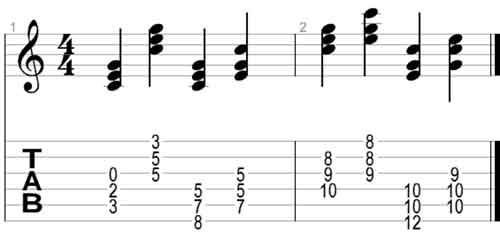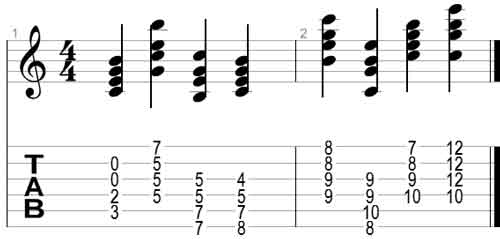LESSON DETAILS
TIME TO COMPLETE: 15 minutes
WHAT YOU NEED: 50 Essential Chords Pack
SKILL LEVEL: Intermediate
The next step past open chords
If you have memorized all chords from the 50 Essential Chords Pack, you’re probably wondering what to do next. While you can learn barre chords, there is another option many players fail to consider. Learning how to find chord shapes all over the neck is a valuable skill and it will take your playing up a whole level. Knowing ten different ways you can play A minor or C Major will make a big difference to your chord vocabulary and ability to jam. This lesson will teach you how to find new chord shapes using the chords you already know.
Extending the chord
When you look at your flash card (in this example we will use C Major), you will notice that the chord contains three notes: C, E & G. Although a couple of the notes are repeated across the strings, the chord only uses those three notes. This means if you can find a new position on your fretboard that uses C, E & G, then the chord will still be C Major (note: a chord with three notes is called a triad). Have a look at the fretboard diagram below and see if you can find a position that allows you to play C, E & G all together.

Once you find a position, try to play the chord. For this exercise it doesn’t matter if the notes aren’t in order (lowest to highest – C E G) as the chord will still be C Major if all three are played. If you have trouble finding a position on the fretboard, the diagram below shows you all the positions of C, E & G.

Now you should start to see plenty of positions where you can place your hand to play a new chord shape. Try to write down all the chord shapes you can physically play. The sheet music below shows a few potential positions.

Extending other chords
The easiest chords to extend across the fretboard are simple three note chords such as Minor, Major, sus2 & sus4. But there’s no reason why you can’t extend other chords across the neck. Let’s look at Cmaj7.
Cmaj7 uses the notes C, E, G & B which is almost the same as C Major. Adding in the B to the chord positions you found earlier changes the chord to Cmaj7. Once you understand this principle, you will find it easy to come up with interesting sounding chords in new positions. The diagram below displays all the positions of C, E, G & B. See how many chord positions you can find.

Don’t worry if you can’t find as many as you could before. This is because it will be harder to find positions where you can comfortably play four notes at once. You must have all four notes for the chord to still be Cmaj7. The sheet music below shows a few positions you can play Cmaj7.

How this skill can help you
Being able to find new chord positions for chords you already know gives you new alternatives over the plain sounding open chords. If you find that you have trouble coming up with interesting sounding progressions, being able to find new chord combinations will open up your playing. This skill will also help your improvising as it will help you get familiar with the positions of chords across the neck. The examples above only looked at the fretboard up to the 12th fret so keep in mind that you can continue to find new shapes above the 12th fret.
Exercises to try
The best way to develop this skill is to use the 50 Essential Chords Pack, as you will have 50 chords you can find new positions for – which is more than enough! But if you haven’t got a pack yet, try the below chords to get started now.
Gsus2: G, A, D
Fmaj7: F, A, C, E
Fm: F, G#, C
